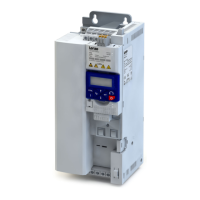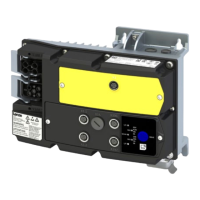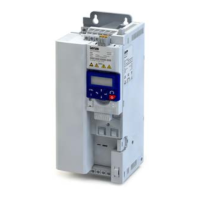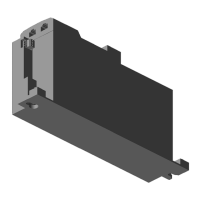Operating instructions i550 cabinet frequency inverter | 27
© 11/2021 · EN · www.Lenze.com
Safe torque o (STO)
DANGER!
No “Emergency switching o” in accordance with EN 60204-1
When using the “Safe torque o (STO)” function, additional measures are required for an
“Emergency switching o” in accordance with EN 60204-1. There is no electrical isolation
between the motor and inverter, no service switch or maintenance switch!
Possible consequences: Death or severe injuries
• An “Emergency switching o” requires an electrical isolation, e.g. by a central mains
contactor.
Control terminals X1
Connection type Spring terminal, pluggable
Max. cable cross-section mm² 1.5
Stripping length mm 9
Required tool
0.4 x 2.5
Application
SIA
SIB
Inputs for connecting active or passive sensors
GS Reference potential for SIA and SIB
Specications for SIA, SIB minimum typical maximum
LOW signal V -3 0 +5
HIGH signal V +15 +24 +30
Runtime ms 3
Switch-o time ms 50 60
Input current SIA mA 10 14
Input current SIB mA 7 12
Input peak current mA 100
Test pulse duration ms 1
Test pulse interval ms 10
Connection of active and passive sensors
The connection diagrams shown are only example circuits. The user is responsible for the
correct safety-related design and selection of the components!
Active sensor Passive sensor
Passive sensor + safety
switching device
X1
SIA
GS
SIB
"
S1
X1
SIA
GS
SIB
"
S1
DC 24 V SELV/PELV
+24 V
0 V
X1
SIA
GS
SIB
"
S2
S1
External power supply unit or 24 V
output of X3
S1: Active sensor
(Example: lightgrid)
S1: Passive sensor S1: Passive sensor
S2: Safety switching device
Safety-related characteristic values and further example circuits can be found in the project
planning document.
Electrical installation
3-phase | 480 V
3-phase | 230/240V
3-phase | 400 V1-phase | 120V
1-phase | 230/240V
Control terminals
Relay output
Connection diagram
Brake resistor
Networks
Functional safety
Safe torque o (STO)
PTC input
Preparation

